An In-Depth Analysis of Toyota's Quality Management Practices
VerifiedAdded on 2020/02/03
|25
|8623
|35
Report
AI Summary
This report provides a comprehensive analysis of Toyota's quality management practices. It begins by defining quality from customer, product, and value-based perspectives, emphasizing the importance of customer satisfaction. The report then traces the historical development of quality management processes, from inspection to total quality management, and outlines the different quality management approaches Toyota employs, including Total Quality Management. It discusses customer satisfaction, continuous improvement, and the benefits of effective quality management for Toyota. The report also examines the use of user and non-user surveys, consultation methods, and complaints procedures in determining and meeting customer needs. Finally, it explores the role of self-assessment, communication, and record-keeping in maintaining and improving quality at Toyota, and proposes potential system modifications for enhanced service quality. The report highlights the evolution of quality management and its critical role in Toyota's success.
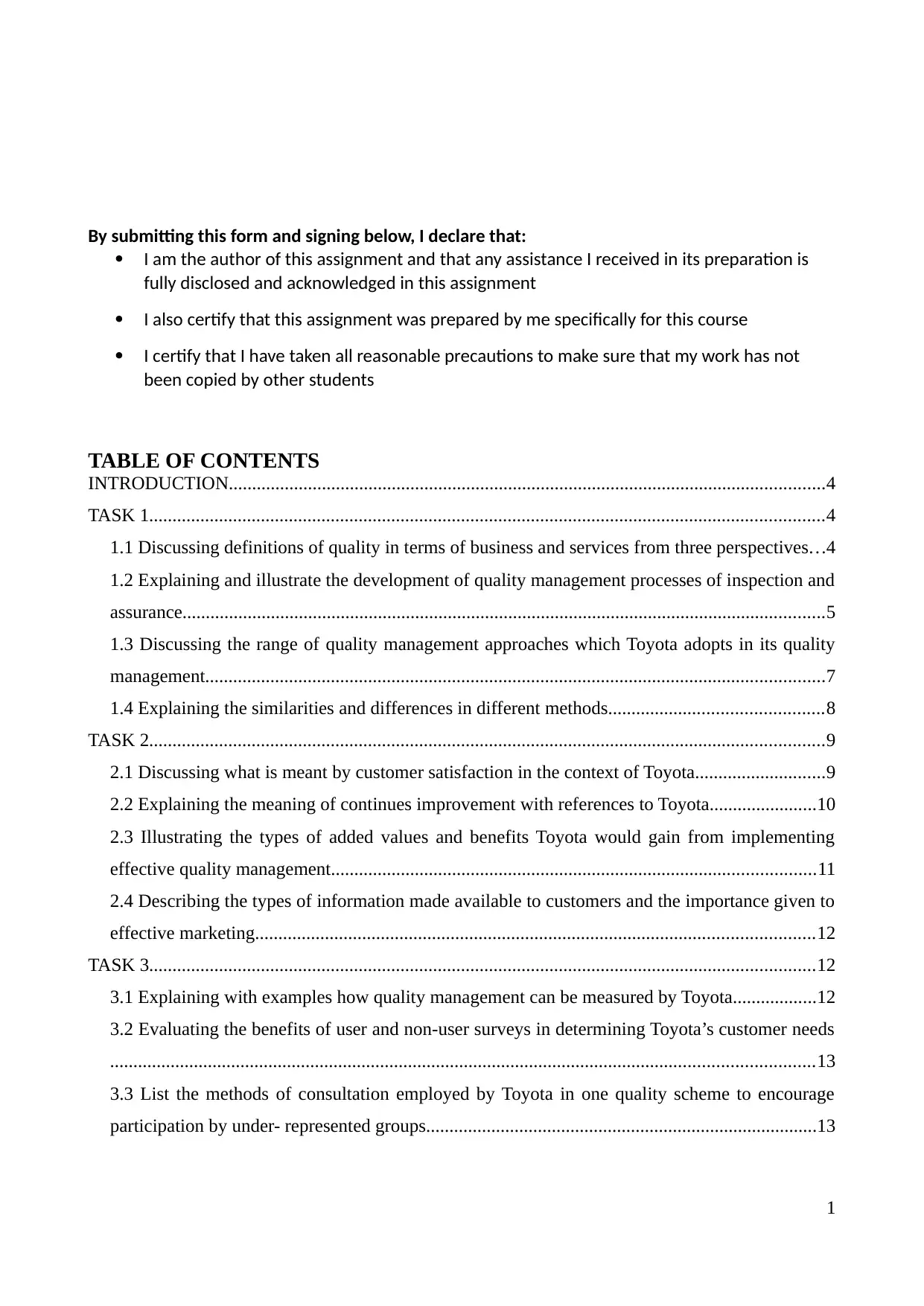
By submitting this form and signing below, I declare that:
I am the author of this assignment and that any assistance I received in its preparation is
fully disclosed and acknowledged in this assignment
I also certify that this assignment was prepared by me specifically for this course
I certify that I have taken all reasonable precautions to make sure that my work has not
been copied by other students
TABLE OF CONTENTS
INTRODUCTION................................................................................................................................4
TASK 1.................................................................................................................................................4
1.1 Discussing definitions of quality in terms of business and services from three perspectives...4
1.2 Explaining and illustrate the development of quality management processes of inspection and
assurance..........................................................................................................................................5
1.3 Discussing the range of quality management approaches which Toyota adopts in its quality
management.....................................................................................................................................7
1.4 Explaining the similarities and differences in different methods..............................................8
TASK 2.................................................................................................................................................9
2.1 Discussing what is meant by customer satisfaction in the context of Toyota............................9
2.2 Explaining the meaning of continues improvement with references to Toyota.......................10
2.3 Illustrating the types of added values and benefits Toyota would gain from implementing
effective quality management........................................................................................................11
2.4 Describing the types of information made available to customers and the importance given to
effective marketing........................................................................................................................12
TASK 3...............................................................................................................................................12
3.1 Explaining with examples how quality management can be measured by Toyota..................12
3.2 Evaluating the benefits of user and non-user surveys in determining Toyota’s customer needs
.......................................................................................................................................................13
3.3 List the methods of consultation employed by Toyota in one quality scheme to encourage
participation by under- represented groups....................................................................................13
1
I am the author of this assignment and that any assistance I received in its preparation is
fully disclosed and acknowledged in this assignment
I also certify that this assignment was prepared by me specifically for this course
I certify that I have taken all reasonable precautions to make sure that my work has not
been copied by other students
TABLE OF CONTENTS
INTRODUCTION................................................................................................................................4
TASK 1.................................................................................................................................................4
1.1 Discussing definitions of quality in terms of business and services from three perspectives...4
1.2 Explaining and illustrate the development of quality management processes of inspection and
assurance..........................................................................................................................................5
1.3 Discussing the range of quality management approaches which Toyota adopts in its quality
management.....................................................................................................................................7
1.4 Explaining the similarities and differences in different methods..............................................8
TASK 2.................................................................................................................................................9
2.1 Discussing what is meant by customer satisfaction in the context of Toyota............................9
2.2 Explaining the meaning of continues improvement with references to Toyota.......................10
2.3 Illustrating the types of added values and benefits Toyota would gain from implementing
effective quality management........................................................................................................11
2.4 Describing the types of information made available to customers and the importance given to
effective marketing........................................................................................................................12
TASK 3...............................................................................................................................................12
3.1 Explaining with examples how quality management can be measured by Toyota..................12
3.2 Evaluating the benefits of user and non-user surveys in determining Toyota’s customer needs
.......................................................................................................................................................13
3.3 List the methods of consultation employed by Toyota in one quality scheme to encourage
participation by under- represented groups....................................................................................13
1
Paraphrase This Document
Need a fresh take? Get an instant paraphrase of this document with our AI Paraphraser
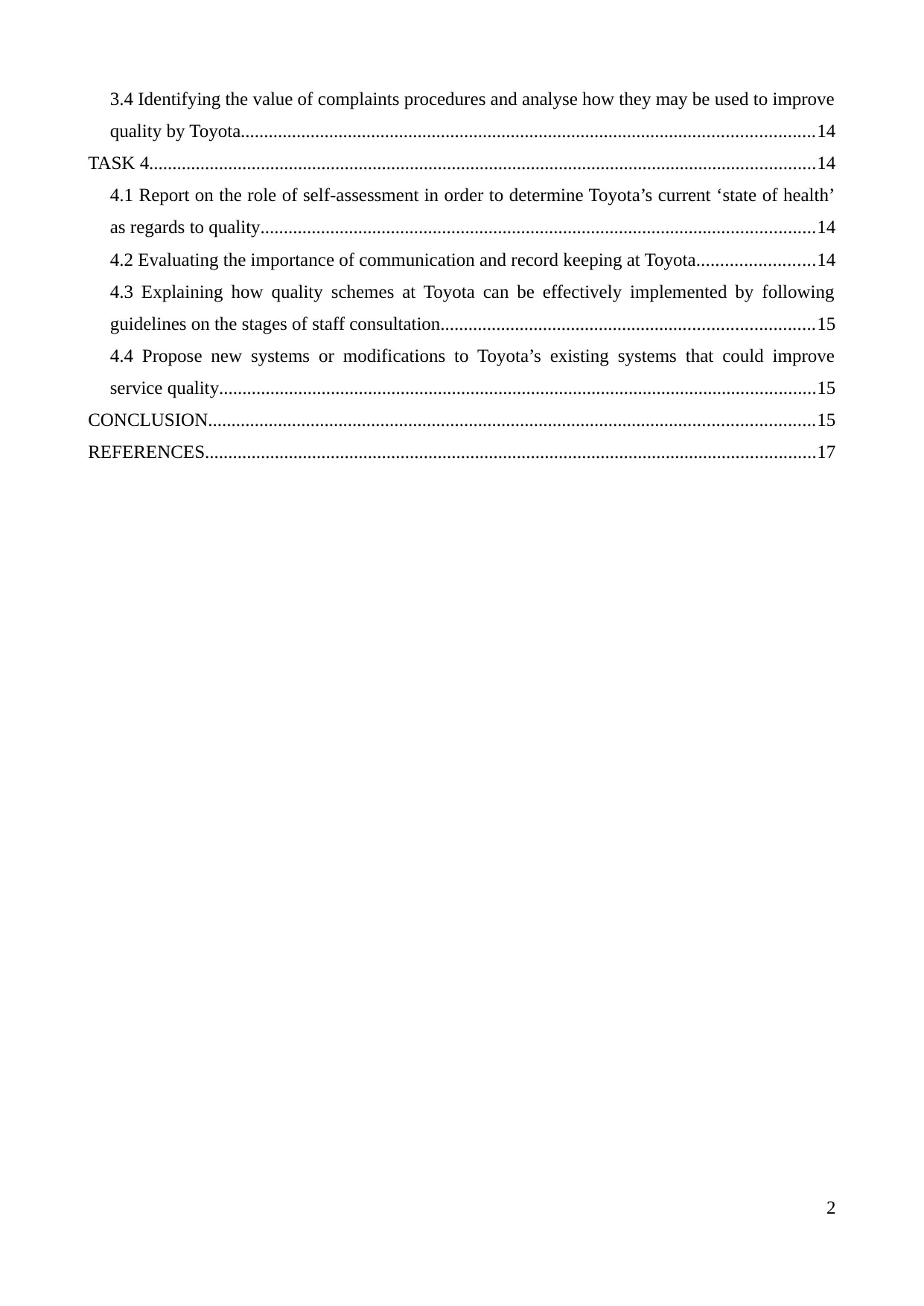
3.4 Identifying the value of complaints procedures and analyse how they may be used to improve
quality by Toyota...........................................................................................................................14
TASK 4...............................................................................................................................................14
4.1 Report on the role of self-assessment in order to determine Toyota’s current ‘state of health’
as regards to quality.......................................................................................................................14
4.2 Evaluating the importance of communication and record keeping at Toyota.........................14
4.3 Explaining how quality schemes at Toyota can be effectively implemented by following
guidelines on the stages of staff consultation................................................................................15
4.4 Propose new systems or modifications to Toyota’s existing systems that could improve
service quality................................................................................................................................15
CONCLUSION..................................................................................................................................15
REFERENCES...................................................................................................................................17
2
quality by Toyota...........................................................................................................................14
TASK 4...............................................................................................................................................14
4.1 Report on the role of self-assessment in order to determine Toyota’s current ‘state of health’
as regards to quality.......................................................................................................................14
4.2 Evaluating the importance of communication and record keeping at Toyota.........................14
4.3 Explaining how quality schemes at Toyota can be effectively implemented by following
guidelines on the stages of staff consultation................................................................................15
4.4 Propose new systems or modifications to Toyota’s existing systems that could improve
service quality................................................................................................................................15
CONCLUSION..................................................................................................................................15
REFERENCES...................................................................................................................................17
2
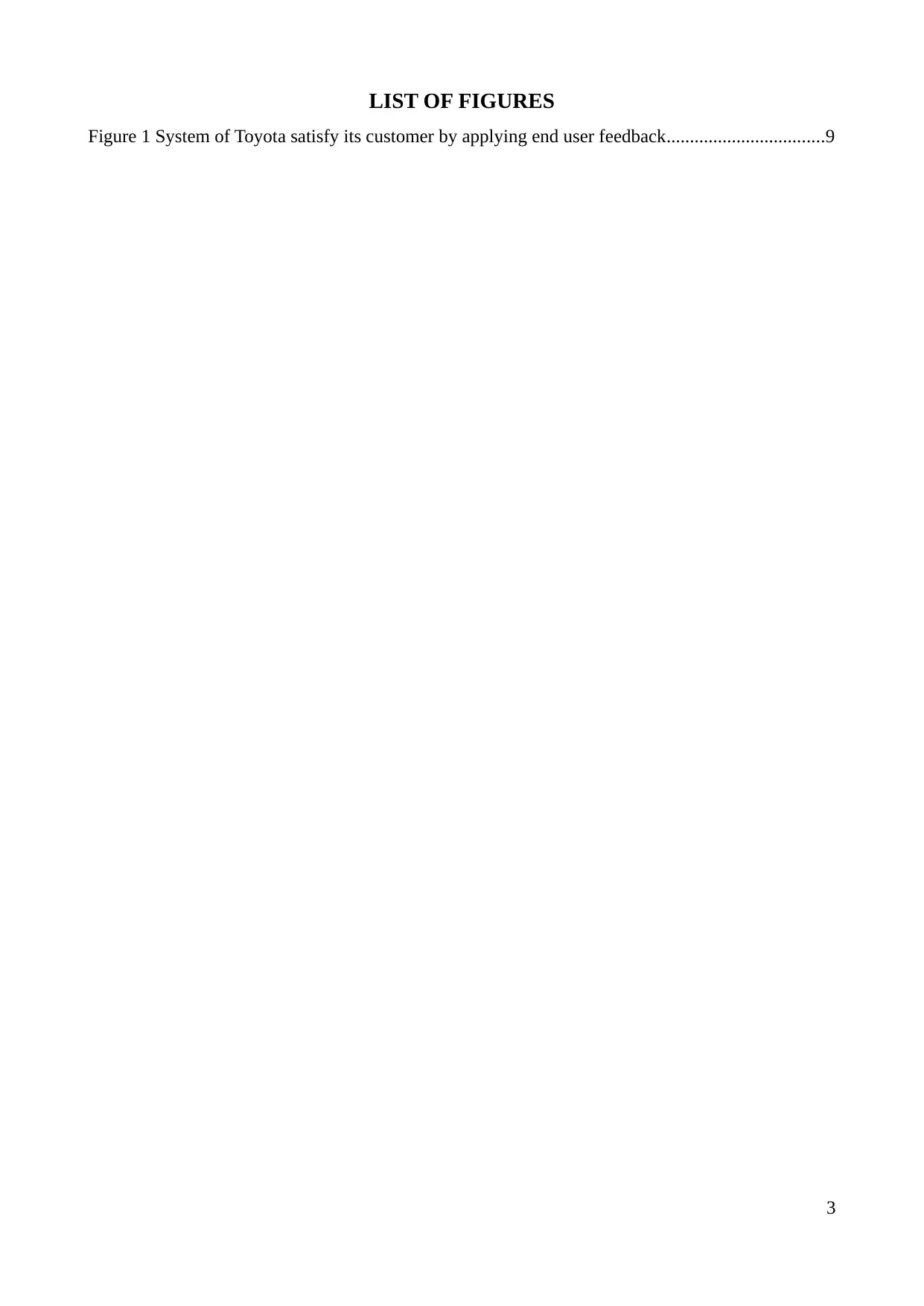
LIST OF FIGURES
Figure 1 System of Toyota satisfy its customer by applying end user feedback..................................9
3
Figure 1 System of Toyota satisfy its customer by applying end user feedback..................................9
3
⊘ This is a preview!⊘
Do you want full access?
Subscribe today to unlock all pages.

Trusted by 1+ million students worldwide
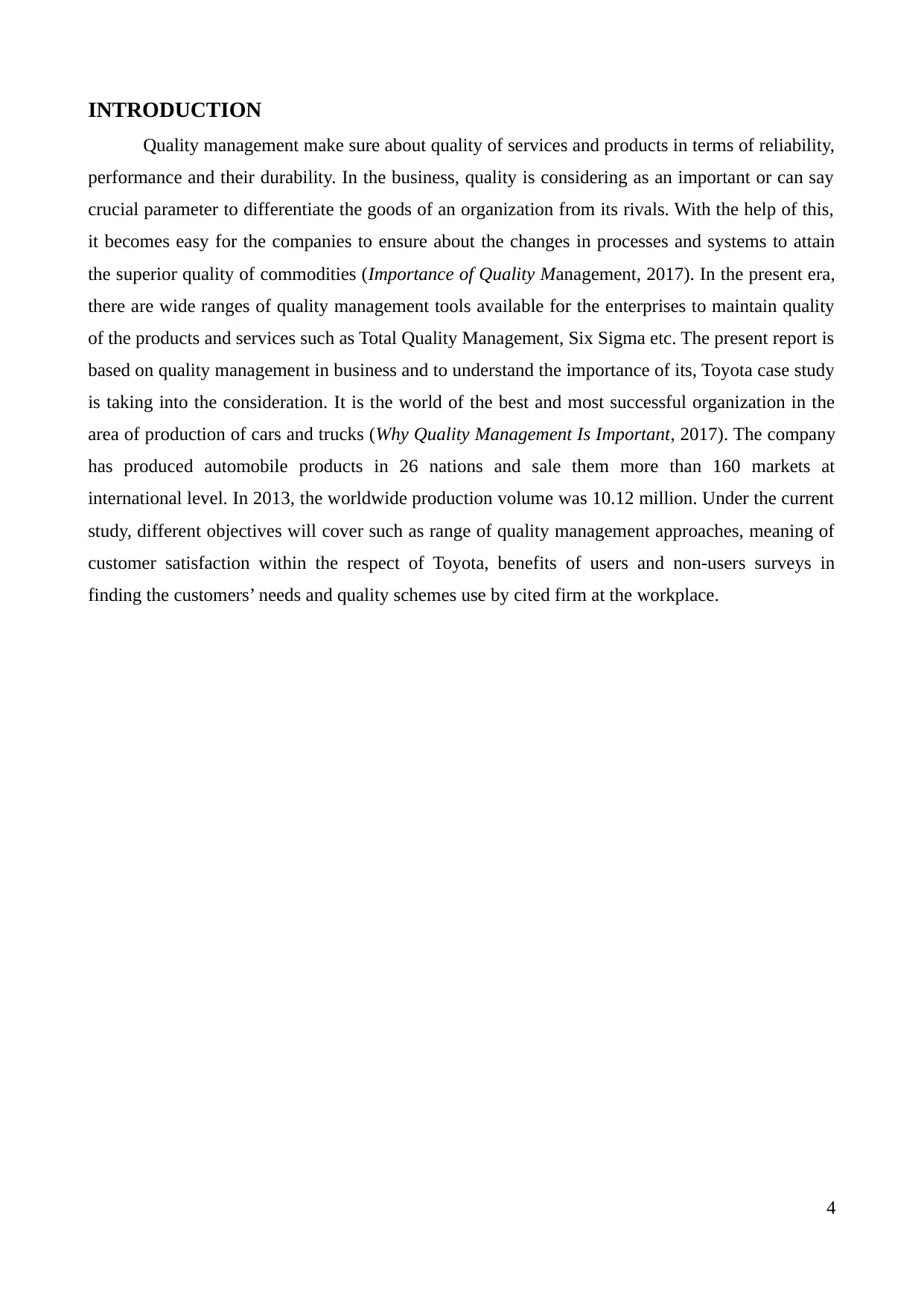
INTRODUCTION
Quality management make sure about quality of services and products in terms of reliability,
performance and their durability. In the business, quality is considering as an important or can say
crucial parameter to differentiate the goods of an organization from its rivals. With the help of this,
it becomes easy for the companies to ensure about the changes in processes and systems to attain
the superior quality of commodities (Importance of Quality Management, 2017). In the present era,
there are wide ranges of quality management tools available for the enterprises to maintain quality
of the products and services such as Total Quality Management, Six Sigma etc. The present report is
based on quality management in business and to understand the importance of its, Toyota case study
is taking into the consideration. It is the world of the best and most successful organization in the
area of production of cars and trucks (Why Quality Management Is Important, 2017). The company
has produced automobile products in 26 nations and sale them more than 160 markets at
international level. In 2013, the worldwide production volume was 10.12 million. Under the current
study, different objectives will cover such as range of quality management approaches, meaning of
customer satisfaction within the respect of Toyota, benefits of users and non-users surveys in
finding the customers’ needs and quality schemes use by cited firm at the workplace.
4
Quality management make sure about quality of services and products in terms of reliability,
performance and their durability. In the business, quality is considering as an important or can say
crucial parameter to differentiate the goods of an organization from its rivals. With the help of this,
it becomes easy for the companies to ensure about the changes in processes and systems to attain
the superior quality of commodities (Importance of Quality Management, 2017). In the present era,
there are wide ranges of quality management tools available for the enterprises to maintain quality
of the products and services such as Total Quality Management, Six Sigma etc. The present report is
based on quality management in business and to understand the importance of its, Toyota case study
is taking into the consideration. It is the world of the best and most successful organization in the
area of production of cars and trucks (Why Quality Management Is Important, 2017). The company
has produced automobile products in 26 nations and sale them more than 160 markets at
international level. In 2013, the worldwide production volume was 10.12 million. Under the current
study, different objectives will cover such as range of quality management approaches, meaning of
customer satisfaction within the respect of Toyota, benefits of users and non-users surveys in
finding the customers’ needs and quality schemes use by cited firm at the workplace.
4
Paraphrase This Document
Need a fresh take? Get an instant paraphrase of this document with our AI Paraphraser
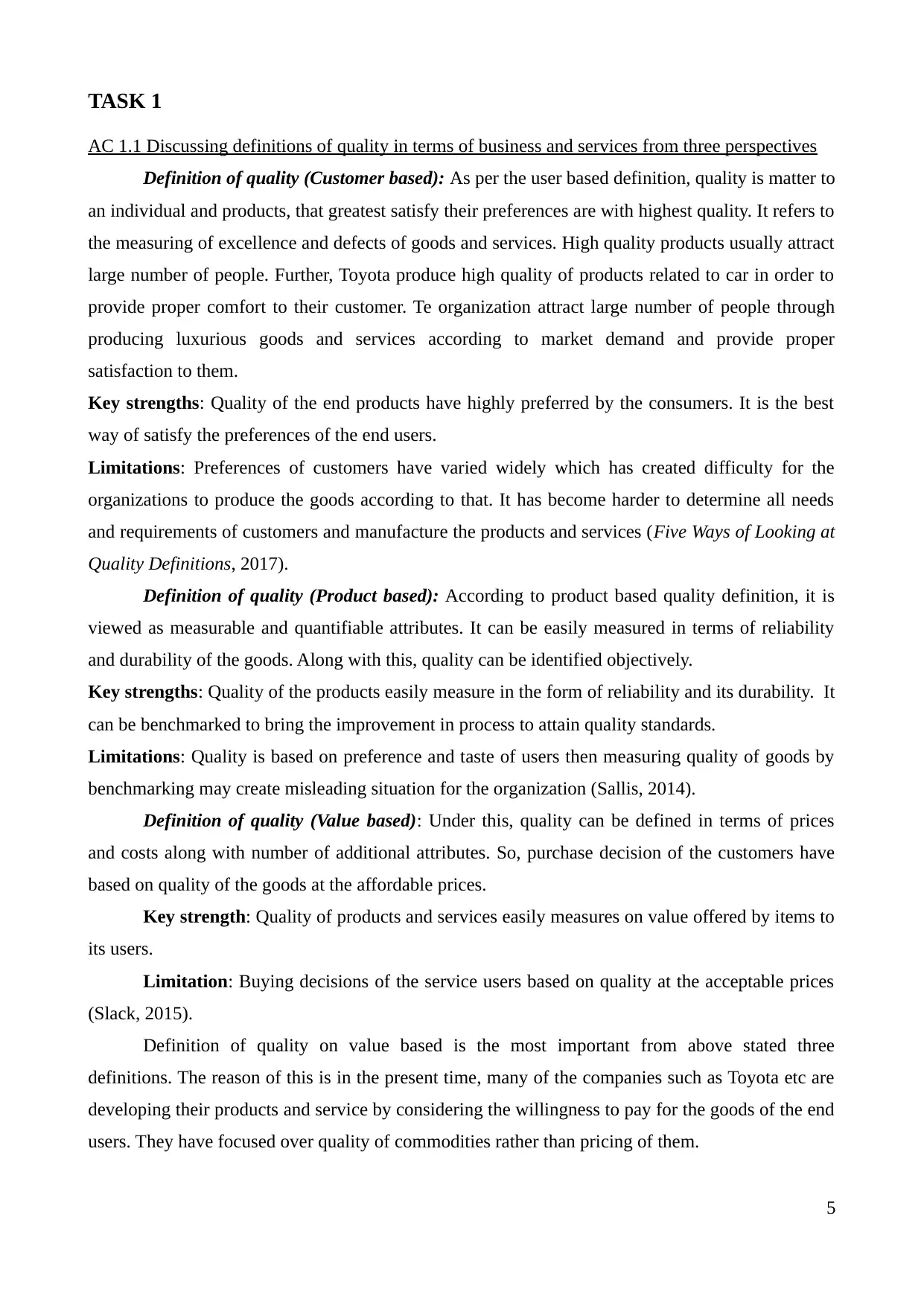
TASK 1
AC 1.1 Discussing definitions of quality in terms of business and services from three perspectives
Definition of quality (Customer based): As per the user based definition, quality is matter to
an individual and products, that greatest satisfy their preferences are with highest quality. It refers to
the measuring of excellence and defects of goods and services. High quality products usually attract
large number of people. Further, Toyota produce high quality of products related to car in order to
provide proper comfort to their customer. Te organization attract large number of people through
producing luxurious goods and services according to market demand and provide proper
satisfaction to them.
Key strengths: Quality of the end products have highly preferred by the consumers. It is the best
way of satisfy the preferences of the end users.
Limitations: Preferences of customers have varied widely which has created difficulty for the
organizations to produce the goods according to that. It has become harder to determine all needs
and requirements of customers and manufacture the products and services (Five Ways of Looking at
Quality Definitions, 2017).
Definition of quality (Product based): According to product based quality definition, it is
viewed as measurable and quantifiable attributes. It can be easily measured in terms of reliability
and durability of the goods. Along with this, quality can be identified objectively.
Key strengths: Quality of the products easily measure in the form of reliability and its durability. It
can be benchmarked to bring the improvement in process to attain quality standards.
Limitations: Quality is based on preference and taste of users then measuring quality of goods by
benchmarking may create misleading situation for the organization (Sallis, 2014).
Definition of quality (Value based): Under this, quality can be defined in terms of prices
and costs along with number of additional attributes. So, purchase decision of the customers have
based on quality of the goods at the affordable prices.
Key strength: Quality of products and services easily measures on value offered by items to
its users.
Limitation: Buying decisions of the service users based on quality at the acceptable prices
(Slack, 2015).
Definition of quality on value based is the most important from above stated three
definitions. The reason of this is in the present time, many of the companies such as Toyota etc are
developing their products and service by considering the willingness to pay for the goods of the end
users. They have focused over quality of commodities rather than pricing of them.
5
AC 1.1 Discussing definitions of quality in terms of business and services from three perspectives
Definition of quality (Customer based): As per the user based definition, quality is matter to
an individual and products, that greatest satisfy their preferences are with highest quality. It refers to
the measuring of excellence and defects of goods and services. High quality products usually attract
large number of people. Further, Toyota produce high quality of products related to car in order to
provide proper comfort to their customer. Te organization attract large number of people through
producing luxurious goods and services according to market demand and provide proper
satisfaction to them.
Key strengths: Quality of the end products have highly preferred by the consumers. It is the best
way of satisfy the preferences of the end users.
Limitations: Preferences of customers have varied widely which has created difficulty for the
organizations to produce the goods according to that. It has become harder to determine all needs
and requirements of customers and manufacture the products and services (Five Ways of Looking at
Quality Definitions, 2017).
Definition of quality (Product based): According to product based quality definition, it is
viewed as measurable and quantifiable attributes. It can be easily measured in terms of reliability
and durability of the goods. Along with this, quality can be identified objectively.
Key strengths: Quality of the products easily measure in the form of reliability and its durability. It
can be benchmarked to bring the improvement in process to attain quality standards.
Limitations: Quality is based on preference and taste of users then measuring quality of goods by
benchmarking may create misleading situation for the organization (Sallis, 2014).
Definition of quality (Value based): Under this, quality can be defined in terms of prices
and costs along with number of additional attributes. So, purchase decision of the customers have
based on quality of the goods at the affordable prices.
Key strength: Quality of products and services easily measures on value offered by items to
its users.
Limitation: Buying decisions of the service users based on quality at the acceptable prices
(Slack, 2015).
Definition of quality on value based is the most important from above stated three
definitions. The reason of this is in the present time, many of the companies such as Toyota etc are
developing their products and service by considering the willingness to pay for the goods of the end
users. They have focused over quality of commodities rather than pricing of them.
5
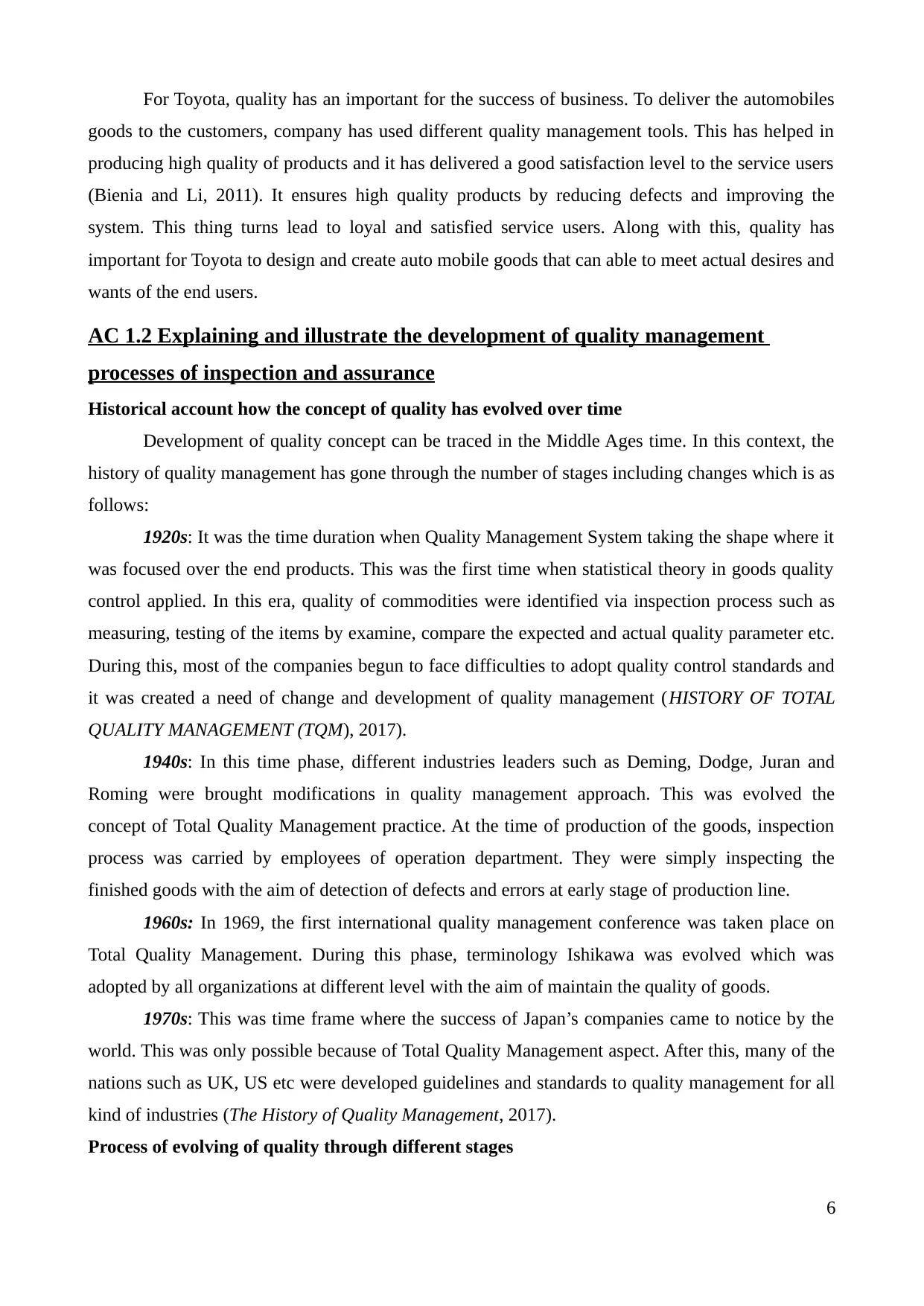
For Toyota, quality has an important for the success of business. To deliver the automobiles
goods to the customers, company has used different quality management tools. This has helped in
producing high quality of products and it has delivered a good satisfaction level to the service users
(Bienia and Li, 2011). It ensures high quality products by reducing defects and improving the
system. This thing turns lead to loyal and satisfied service users. Along with this, quality has
important for Toyota to design and create auto mobile goods that can able to meet actual desires and
wants of the end users.
AC 1.2 Explaining and illustrate the development of quality management
processes of inspection and assurance
Historical account how the concept of quality has evolved over time
Development of quality concept can be traced in the Middle Ages time. In this context, the
history of quality management has gone through the number of stages including changes which is as
follows:
1920s: It was the time duration when Quality Management System taking the shape where it
was focused over the end products. This was the first time when statistical theory in goods quality
control applied. In this era, quality of commodities were identified via inspection process such as
measuring, testing of the items by examine, compare the expected and actual quality parameter etc.
During this, most of the companies begun to face difficulties to adopt quality control standards and
it was created a need of change and development of quality management (HISTORY OF TOTAL
QUALITY MANAGEMENT (TQM), 2017).
1940s: In this time phase, different industries leaders such as Deming, Dodge, Juran and
Roming were brought modifications in quality management approach. This was evolved the
concept of Total Quality Management practice. At the time of production of the goods, inspection
process was carried by employees of operation department. They were simply inspecting the
finished goods with the aim of detection of defects and errors at early stage of production line.
1960s: In 1969, the first international quality management conference was taken place on
Total Quality Management. During this phase, terminology Ishikawa was evolved which was
adopted by all organizations at different level with the aim of maintain the quality of goods.
1970s: This was time frame where the success of Japan’s companies came to notice by the
world. This was only possible because of Total Quality Management aspect. After this, many of the
nations such as UK, US etc were developed guidelines and standards to quality management for all
kind of industries (The History of Quality Management, 2017).
Process of evolving of quality through different stages
6
goods to the customers, company has used different quality management tools. This has helped in
producing high quality of products and it has delivered a good satisfaction level to the service users
(Bienia and Li, 2011). It ensures high quality products by reducing defects and improving the
system. This thing turns lead to loyal and satisfied service users. Along with this, quality has
important for Toyota to design and create auto mobile goods that can able to meet actual desires and
wants of the end users.
AC 1.2 Explaining and illustrate the development of quality management
processes of inspection and assurance
Historical account how the concept of quality has evolved over time
Development of quality concept can be traced in the Middle Ages time. In this context, the
history of quality management has gone through the number of stages including changes which is as
follows:
1920s: It was the time duration when Quality Management System taking the shape where it
was focused over the end products. This was the first time when statistical theory in goods quality
control applied. In this era, quality of commodities were identified via inspection process such as
measuring, testing of the items by examine, compare the expected and actual quality parameter etc.
During this, most of the companies begun to face difficulties to adopt quality control standards and
it was created a need of change and development of quality management (HISTORY OF TOTAL
QUALITY MANAGEMENT (TQM), 2017).
1940s: In this time phase, different industries leaders such as Deming, Dodge, Juran and
Roming were brought modifications in quality management approach. This was evolved the
concept of Total Quality Management practice. At the time of production of the goods, inspection
process was carried by employees of operation department. They were simply inspecting the
finished goods with the aim of detection of defects and errors at early stage of production line.
1960s: In 1969, the first international quality management conference was taken place on
Total Quality Management. During this phase, terminology Ishikawa was evolved which was
adopted by all organizations at different level with the aim of maintain the quality of goods.
1970s: This was time frame where the success of Japan’s companies came to notice by the
world. This was only possible because of Total Quality Management aspect. After this, many of the
nations such as UK, US etc were developed guidelines and standards to quality management for all
kind of industries (The History of Quality Management, 2017).
Process of evolving of quality through different stages
6
⊘ This is a preview!⊘
Do you want full access?
Subscribe today to unlock all pages.

Trusted by 1+ million students worldwide
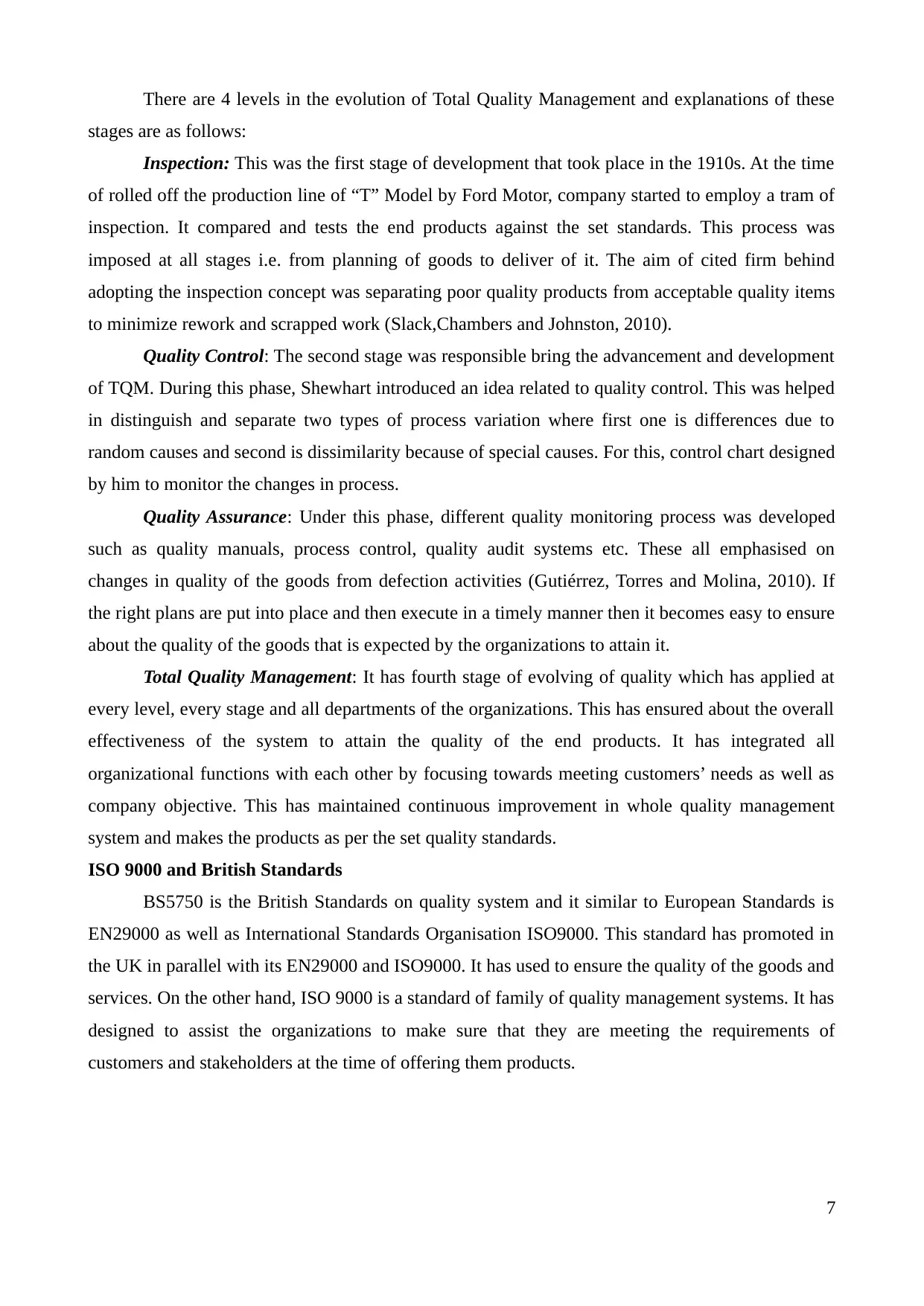
There are 4 levels in the evolution of Total Quality Management and explanations of these
stages are as follows:
Inspection: This was the first stage of development that took place in the 1910s. At the time
of rolled off the production line of “T” Model by Ford Motor, company started to employ a tram of
inspection. It compared and tests the end products against the set standards. This process was
imposed at all stages i.e. from planning of goods to deliver of it. The aim of cited firm behind
adopting the inspection concept was separating poor quality products from acceptable quality items
to minimize rework and scrapped work (Slack,Chambers and Johnston, 2010).
Quality Control: The second stage was responsible bring the advancement and development
of TQM. During this phase, Shewhart introduced an idea related to quality control. This was helped
in distinguish and separate two types of process variation where first one is differences due to
random causes and second is dissimilarity because of special causes. For this, control chart designed
by him to monitor the changes in process.
Quality Assurance: Under this phase, different quality monitoring process was developed
such as quality manuals, process control, quality audit systems etc. These all emphasised on
changes in quality of the goods from defection activities (Gutiérrez, Torres and Molina, 2010). If
the right plans are put into place and then execute in a timely manner then it becomes easy to ensure
about the quality of the goods that is expected by the organizations to attain it.
Total Quality Management: It has fourth stage of evolving of quality which has applied at
every level, every stage and all departments of the organizations. This has ensured about the overall
effectiveness of the system to attain the quality of the end products. It has integrated all
organizational functions with each other by focusing towards meeting customers’ needs as well as
company objective. This has maintained continuous improvement in whole quality management
system and makes the products as per the set quality standards.
ISO 9000 and British Standards
BS5750 is the British Standards on quality system and it similar to European Standards is
EN29000 as well as International Standards Organisation ISO9000. This standard has promoted in
the UK in parallel with its EN29000 and ISO9000. It has used to ensure the quality of the goods and
services. On the other hand, ISO 9000 is a standard of family of quality management systems. It has
designed to assist the organizations to make sure that they are meeting the requirements of
customers and stakeholders at the time of offering them products.
7
stages are as follows:
Inspection: This was the first stage of development that took place in the 1910s. At the time
of rolled off the production line of “T” Model by Ford Motor, company started to employ a tram of
inspection. It compared and tests the end products against the set standards. This process was
imposed at all stages i.e. from planning of goods to deliver of it. The aim of cited firm behind
adopting the inspection concept was separating poor quality products from acceptable quality items
to minimize rework and scrapped work (Slack,Chambers and Johnston, 2010).
Quality Control: The second stage was responsible bring the advancement and development
of TQM. During this phase, Shewhart introduced an idea related to quality control. This was helped
in distinguish and separate two types of process variation where first one is differences due to
random causes and second is dissimilarity because of special causes. For this, control chart designed
by him to monitor the changes in process.
Quality Assurance: Under this phase, different quality monitoring process was developed
such as quality manuals, process control, quality audit systems etc. These all emphasised on
changes in quality of the goods from defection activities (Gutiérrez, Torres and Molina, 2010). If
the right plans are put into place and then execute in a timely manner then it becomes easy to ensure
about the quality of the goods that is expected by the organizations to attain it.
Total Quality Management: It has fourth stage of evolving of quality which has applied at
every level, every stage and all departments of the organizations. This has ensured about the overall
effectiveness of the system to attain the quality of the end products. It has integrated all
organizational functions with each other by focusing towards meeting customers’ needs as well as
company objective. This has maintained continuous improvement in whole quality management
system and makes the products as per the set quality standards.
ISO 9000 and British Standards
BS5750 is the British Standards on quality system and it similar to European Standards is
EN29000 as well as International Standards Organisation ISO9000. This standard has promoted in
the UK in parallel with its EN29000 and ISO9000. It has used to ensure the quality of the goods and
services. On the other hand, ISO 9000 is a standard of family of quality management systems. It has
designed to assist the organizations to make sure that they are meeting the requirements of
customers and stakeholders at the time of offering them products.
7
Paraphrase This Document
Need a fresh take? Get an instant paraphrase of this document with our AI Paraphraser
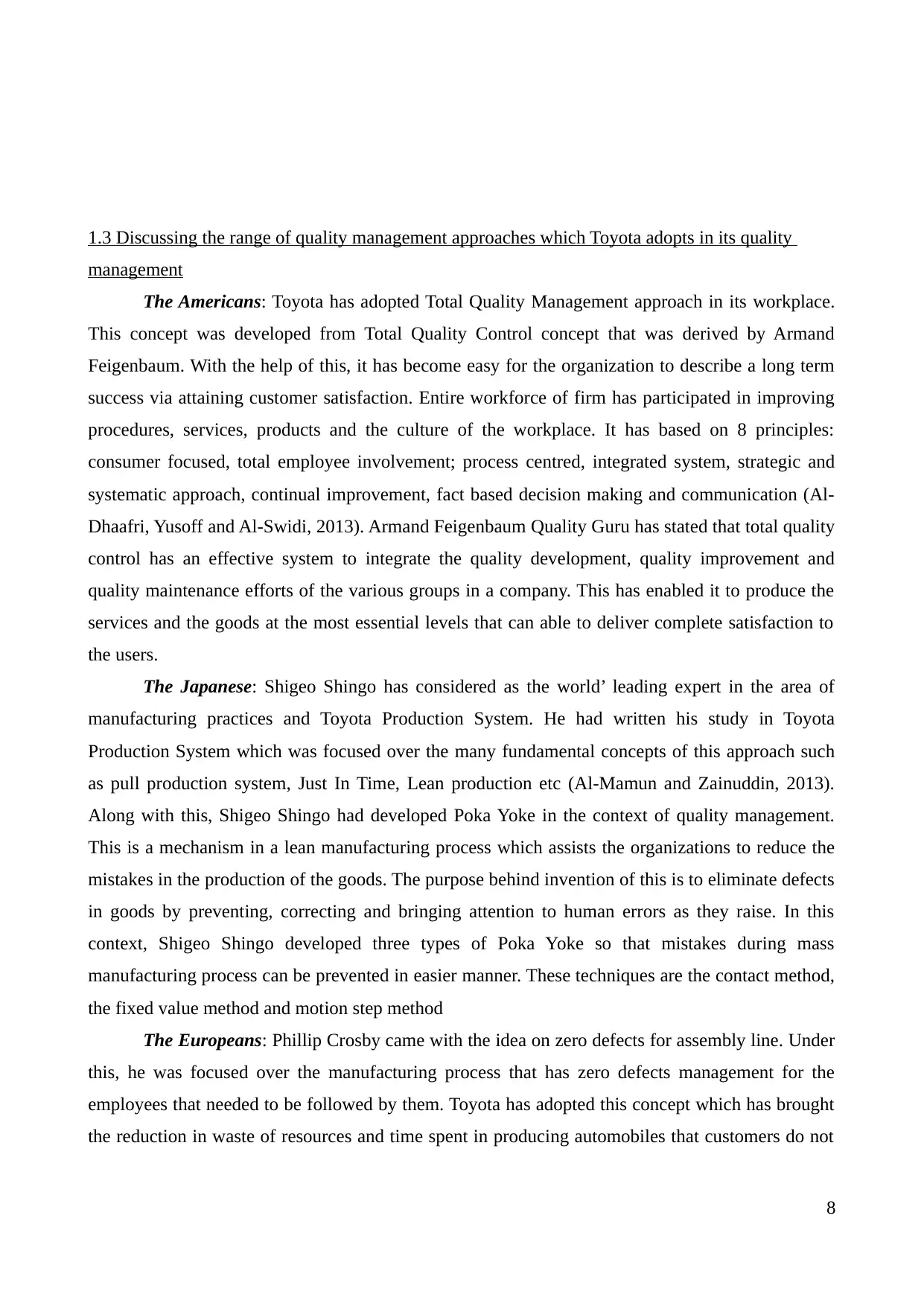
1.3 Discussing the range of quality management approaches which Toyota adopts in its quality
management
The Americans: Toyota has adopted Total Quality Management approach in its workplace.
This concept was developed from Total Quality Control concept that was derived by Armand
Feigenbaum. With the help of this, it has become easy for the organization to describe a long term
success via attaining customer satisfaction. Entire workforce of firm has participated in improving
procedures, services, products and the culture of the workplace. It has based on 8 principles:
consumer focused, total employee involvement; process centred, integrated system, strategic and
systematic approach, continual improvement, fact based decision making and communication (Al-
Dhaafri, Yusoff and Al-Swidi, 2013). Armand Feigenbaum Quality Guru has stated that total quality
control has an effective system to integrate the quality development, quality improvement and
quality maintenance efforts of the various groups in a company. This has enabled it to produce the
services and the goods at the most essential levels that can able to deliver complete satisfaction to
the users.
The Japanese: Shigeo Shingo has considered as the world’ leading expert in the area of
manufacturing practices and Toyota Production System. He had written his study in Toyota
Production System which was focused over the many fundamental concepts of this approach such
as pull production system, Just In Time, Lean production etc (Al-Mamun and Zainuddin, 2013).
Along with this, Shigeo Shingo had developed Poka Yoke in the context of quality management.
This is a mechanism in a lean manufacturing process which assists the organizations to reduce the
mistakes in the production of the goods. The purpose behind invention of this is to eliminate defects
in goods by preventing, correcting and bringing attention to human errors as they raise. In this
context, Shigeo Shingo developed three types of Poka Yoke so that mistakes during mass
manufacturing process can be prevented in easier manner. These techniques are the contact method,
the fixed value method and motion step method
The Europeans: Phillip Crosby came with the idea on zero defects for assembly line. Under
this, he was focused over the manufacturing process that has zero defects management for the
employees that needed to be followed by them. Toyota has adopted this concept which has brought
the reduction in waste of resources and time spent in producing automobiles that customers do not
8
management
The Americans: Toyota has adopted Total Quality Management approach in its workplace.
This concept was developed from Total Quality Control concept that was derived by Armand
Feigenbaum. With the help of this, it has become easy for the organization to describe a long term
success via attaining customer satisfaction. Entire workforce of firm has participated in improving
procedures, services, products and the culture of the workplace. It has based on 8 principles:
consumer focused, total employee involvement; process centred, integrated system, strategic and
systematic approach, continual improvement, fact based decision making and communication (Al-
Dhaafri, Yusoff and Al-Swidi, 2013). Armand Feigenbaum Quality Guru has stated that total quality
control has an effective system to integrate the quality development, quality improvement and
quality maintenance efforts of the various groups in a company. This has enabled it to produce the
services and the goods at the most essential levels that can able to deliver complete satisfaction to
the users.
The Japanese: Shigeo Shingo has considered as the world’ leading expert in the area of
manufacturing practices and Toyota Production System. He had written his study in Toyota
Production System which was focused over the many fundamental concepts of this approach such
as pull production system, Just In Time, Lean production etc (Al-Mamun and Zainuddin, 2013).
Along with this, Shigeo Shingo had developed Poka Yoke in the context of quality management.
This is a mechanism in a lean manufacturing process which assists the organizations to reduce the
mistakes in the production of the goods. The purpose behind invention of this is to eliminate defects
in goods by preventing, correcting and bringing attention to human errors as they raise. In this
context, Shigeo Shingo developed three types of Poka Yoke so that mistakes during mass
manufacturing process can be prevented in easier manner. These techniques are the contact method,
the fixed value method and motion step method
The Europeans: Phillip Crosby came with the idea on zero defects for assembly line. Under
this, he was focused over the manufacturing process that has zero defects management for the
employees that needed to be followed by them. Toyota has adopted this concept which has brought
the reduction in waste of resources and time spent in producing automobiles that customers do not
8
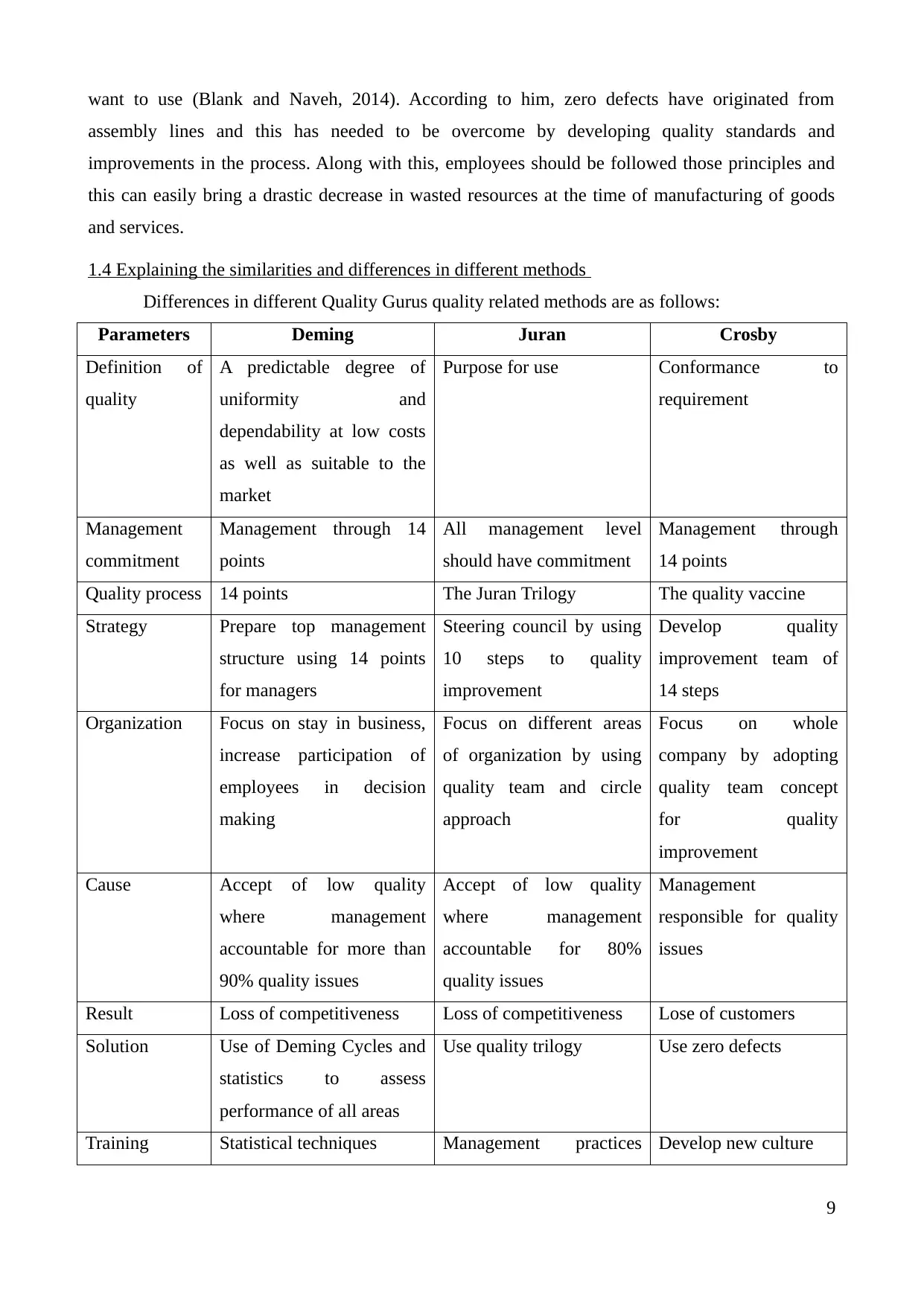
want to use (Blank and Naveh, 2014). According to him, zero defects have originated from
assembly lines and this has needed to be overcome by developing quality standards and
improvements in the process. Along with this, employees should be followed those principles and
this can easily bring a drastic decrease in wasted resources at the time of manufacturing of goods
and services.
1.4 Explaining the similarities and differences in different methods
Differences in different Quality Gurus quality related methods are as follows:
Parameters Deming Juran Crosby
Definition of
quality
A predictable degree of
uniformity and
dependability at low costs
as well as suitable to the
market
Purpose for use Conformance to
requirement
Management
commitment
Management through 14
points
All management level
should have commitment
Management through
14 points
Quality process 14 points The Juran Trilogy The quality vaccine
Strategy Prepare top management
structure using 14 points
for managers
Steering council by using
10 steps to quality
improvement
Develop quality
improvement team of
14 steps
Organization Focus on stay in business,
increase participation of
employees in decision
making
Focus on different areas
of organization by using
quality team and circle
approach
Focus on whole
company by adopting
quality team concept
for quality
improvement
Cause Accept of low quality
where management
accountable for more than
90% quality issues
Accept of low quality
where management
accountable for 80%
quality issues
Management
responsible for quality
issues
Result Loss of competitiveness Loss of competitiveness Lose of customers
Solution Use of Deming Cycles and
statistics to assess
performance of all areas
Use quality trilogy Use zero defects
Training Statistical techniques Management practices Develop new culture
9
assembly lines and this has needed to be overcome by developing quality standards and
improvements in the process. Along with this, employees should be followed those principles and
this can easily bring a drastic decrease in wasted resources at the time of manufacturing of goods
and services.
1.4 Explaining the similarities and differences in different methods
Differences in different Quality Gurus quality related methods are as follows:
Parameters Deming Juran Crosby
Definition of
quality
A predictable degree of
uniformity and
dependability at low costs
as well as suitable to the
market
Purpose for use Conformance to
requirement
Management
commitment
Management through 14
points
All management level
should have commitment
Management through
14 points
Quality process 14 points The Juran Trilogy The quality vaccine
Strategy Prepare top management
structure using 14 points
for managers
Steering council by using
10 steps to quality
improvement
Develop quality
improvement team of
14 steps
Organization Focus on stay in business,
increase participation of
employees in decision
making
Focus on different areas
of organization by using
quality team and circle
approach
Focus on whole
company by adopting
quality team concept
for quality
improvement
Cause Accept of low quality
where management
accountable for more than
90% quality issues
Accept of low quality
where management
accountable for 80%
quality issues
Management
responsible for quality
issues
Result Loss of competitiveness Loss of competitiveness Lose of customers
Solution Use of Deming Cycles and
statistics to assess
performance of all areas
Use quality trilogy Use zero defects
Training Statistical techniques Management practices Develop new culture
9
⊘ This is a preview!⊘
Do you want full access?
Subscribe today to unlock all pages.

Trusted by 1+ million students worldwide
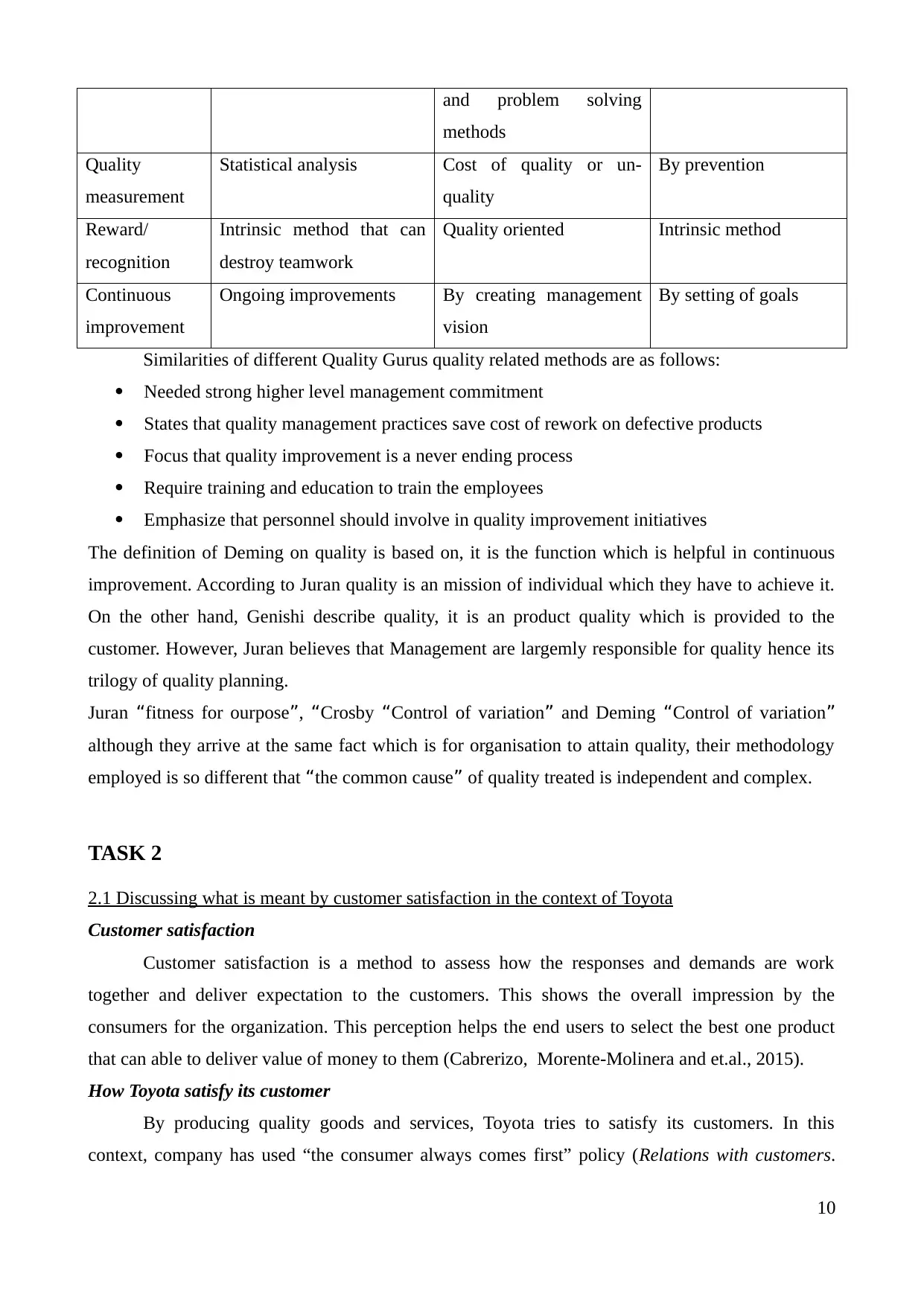
and problem solving
methods
Quality
measurement
Statistical analysis Cost of quality or un-
quality
By prevention
Reward/
recognition
Intrinsic method that can
destroy teamwork
Quality oriented Intrinsic method
Continuous
improvement
Ongoing improvements By creating management
vision
By setting of goals
Similarities of different Quality Gurus quality related methods are as follows:
Needed strong higher level management commitment
States that quality management practices save cost of rework on defective products
Focus that quality improvement is a never ending process
Require training and education to train the employees
Emphasize that personnel should involve in quality improvement initiatives
The definition of Deming on quality is based on, it is the function which is helpful in continuous
improvement. According to Juran quality is an mission of individual which they have to achieve it.
On the other hand, Genishi describe quality, it is an product quality which is provided to the
customer. However, Juran believes that Management are largemly responsible for quality hence its
trilogy of quality planning.
Juran “fitness for ourpose”, “Crosby “Control of variation” and Deming “Control of variation”
although they arrive at the same fact which is for organisation to attain quality, their methodology
employed is so different that “the common cause” of quality treated is independent and complex.
TASK 2
2.1 Discussing what is meant by customer satisfaction in the context of Toyota
Customer satisfaction
Customer satisfaction is a method to assess how the responses and demands are work
together and deliver expectation to the customers. This shows the overall impression by the
consumers for the organization. This perception helps the end users to select the best one product
that can able to deliver value of money to them (Cabrerizo, Morente-Molinera and et.al., 2015).
How Toyota satisfy its customer
By producing quality goods and services, Toyota tries to satisfy its customers. In this
context, company has used “the consumer always comes first” policy (Relations with customers.
10
methods
Quality
measurement
Statistical analysis Cost of quality or un-
quality
By prevention
Reward/
recognition
Intrinsic method that can
destroy teamwork
Quality oriented Intrinsic method
Continuous
improvement
Ongoing improvements By creating management
vision
By setting of goals
Similarities of different Quality Gurus quality related methods are as follows:
Needed strong higher level management commitment
States that quality management practices save cost of rework on defective products
Focus that quality improvement is a never ending process
Require training and education to train the employees
Emphasize that personnel should involve in quality improvement initiatives
The definition of Deming on quality is based on, it is the function which is helpful in continuous
improvement. According to Juran quality is an mission of individual which they have to achieve it.
On the other hand, Genishi describe quality, it is an product quality which is provided to the
customer. However, Juran believes that Management are largemly responsible for quality hence its
trilogy of quality planning.
Juran “fitness for ourpose”, “Crosby “Control of variation” and Deming “Control of variation”
although they arrive at the same fact which is for organisation to attain quality, their methodology
employed is so different that “the common cause” of quality treated is independent and complex.
TASK 2
2.1 Discussing what is meant by customer satisfaction in the context of Toyota
Customer satisfaction
Customer satisfaction is a method to assess how the responses and demands are work
together and deliver expectation to the customers. This shows the overall impression by the
consumers for the organization. This perception helps the end users to select the best one product
that can able to deliver value of money to them (Cabrerizo, Morente-Molinera and et.al., 2015).
How Toyota satisfy its customer
By producing quality goods and services, Toyota tries to satisfy its customers. In this
context, company has used “the consumer always comes first” policy (Relations with customers.
10
Paraphrase This Document
Need a fresh take? Get an instant paraphrase of this document with our AI Paraphraser
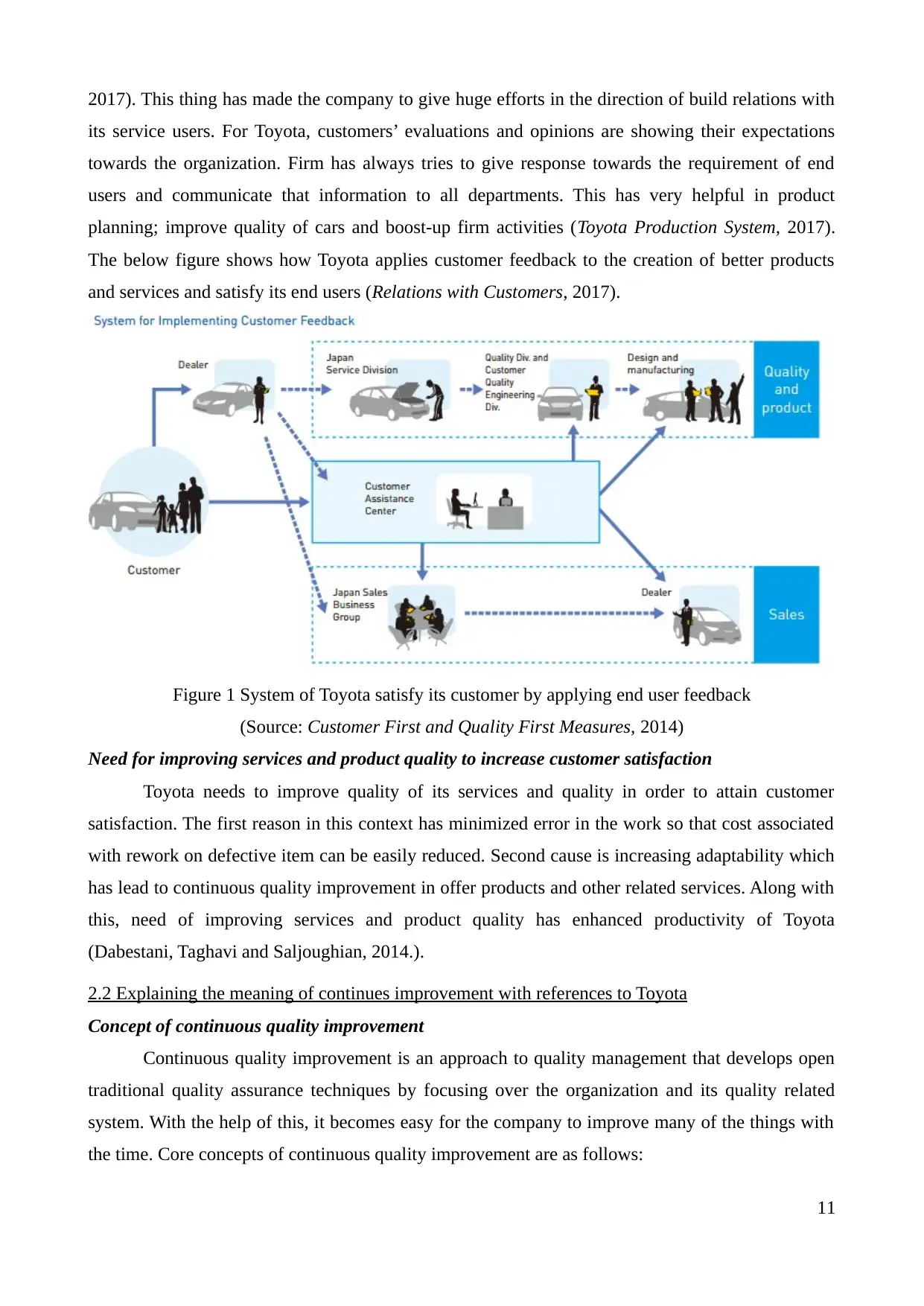
2017). This thing has made the company to give huge efforts in the direction of build relations with
its service users. For Toyota, customers’ evaluations and opinions are showing their expectations
towards the organization. Firm has always tries to give response towards the requirement of end
users and communicate that information to all departments. This has very helpful in product
planning; improve quality of cars and boost-up firm activities (Toyota Production System, 2017).
The below figure shows how Toyota applies customer feedback to the creation of better products
and services and satisfy its end users (Relations with Customers, 2017).
Figure 1 System of Toyota satisfy its customer by applying end user feedback
(Source: Customer First and Quality First Measures, 2014)
Need for improving services and product quality to increase customer satisfaction
Toyota needs to improve quality of its services and quality in order to attain customer
satisfaction. The first reason in this context has minimized error in the work so that cost associated
with rework on defective item can be easily reduced. Second cause is increasing adaptability which
has lead to continuous quality improvement in offer products and other related services. Along with
this, need of improving services and product quality has enhanced productivity of Toyota
(Dabestani, Taghavi and Saljoughian, 2014.).
2.2 Explaining the meaning of continues improvement with references to Toyota
Concept of continuous quality improvement
Continuous quality improvement is an approach to quality management that develops open
traditional quality assurance techniques by focusing over the organization and its quality related
system. With the help of this, it becomes easy for the company to improve many of the things with
the time. Core concepts of continuous quality improvement are as follows:
11
its service users. For Toyota, customers’ evaluations and opinions are showing their expectations
towards the organization. Firm has always tries to give response towards the requirement of end
users and communicate that information to all departments. This has very helpful in product
planning; improve quality of cars and boost-up firm activities (Toyota Production System, 2017).
The below figure shows how Toyota applies customer feedback to the creation of better products
and services and satisfy its end users (Relations with Customers, 2017).
Figure 1 System of Toyota satisfy its customer by applying end user feedback
(Source: Customer First and Quality First Measures, 2014)
Need for improving services and product quality to increase customer satisfaction
Toyota needs to improve quality of its services and quality in order to attain customer
satisfaction. The first reason in this context has minimized error in the work so that cost associated
with rework on defective item can be easily reduced. Second cause is increasing adaptability which
has lead to continuous quality improvement in offer products and other related services. Along with
this, need of improving services and product quality has enhanced productivity of Toyota
(Dabestani, Taghavi and Saljoughian, 2014.).
2.2 Explaining the meaning of continues improvement with references to Toyota
Concept of continuous quality improvement
Continuous quality improvement is an approach to quality management that develops open
traditional quality assurance techniques by focusing over the organization and its quality related
system. With the help of this, it becomes easy for the company to improve many of the things with
the time. Core concepts of continuous quality improvement are as follows:
11
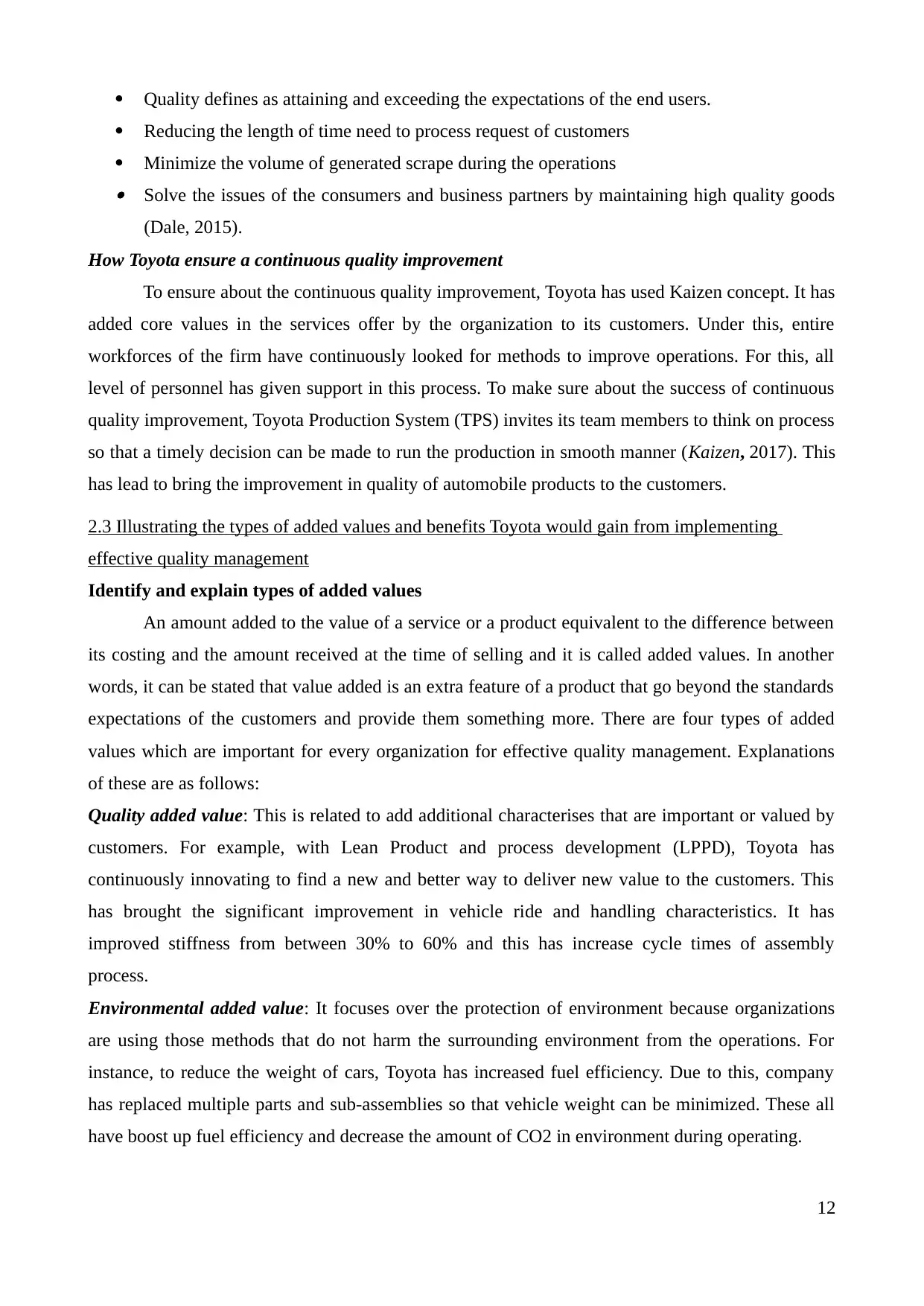
Quality defines as attaining and exceeding the expectations of the end users.
Reducing the length of time need to process request of customers
Minimize the volume of generated scrape during the operations Solve the issues of the consumers and business partners by maintaining high quality goods
(Dale, 2015).
How Toyota ensure a continuous quality improvement
To ensure about the continuous quality improvement, Toyota has used Kaizen concept. It has
added core values in the services offer by the organization to its customers. Under this, entire
workforces of the firm have continuously looked for methods to improve operations. For this, all
level of personnel has given support in this process. To make sure about the success of continuous
quality improvement, Toyota Production System (TPS) invites its team members to think on process
so that a timely decision can be made to run the production in smooth manner (Kaizen, 2017). This
has lead to bring the improvement in quality of automobile products to the customers.
2.3 Illustrating the types of added values and benefits Toyota would gain from implementing
effective quality management
Identify and explain types of added values
An amount added to the value of a service or a product equivalent to the difference between
its costing and the amount received at the time of selling and it is called added values. In another
words, it can be stated that value added is an extra feature of a product that go beyond the standards
expectations of the customers and provide them something more. There are four types of added
values which are important for every organization for effective quality management. Explanations
of these are as follows:
Quality added value: This is related to add additional characterises that are important or valued by
customers. For example, with Lean Product and process development (LPPD), Toyota has
continuously innovating to find a new and better way to deliver new value to the customers. This
has brought the significant improvement in vehicle ride and handling characteristics. It has
improved stiffness from between 30% to 60% and this has increase cycle times of assembly
process.
Environmental added value: It focuses over the protection of environment because organizations
are using those methods that do not harm the surrounding environment from the operations. For
instance, to reduce the weight of cars, Toyota has increased fuel efficiency. Due to this, company
has replaced multiple parts and sub-assemblies so that vehicle weight can be minimized. These all
have boost up fuel efficiency and decrease the amount of CO2 in environment during operating.
12
Reducing the length of time need to process request of customers
Minimize the volume of generated scrape during the operations Solve the issues of the consumers and business partners by maintaining high quality goods
(Dale, 2015).
How Toyota ensure a continuous quality improvement
To ensure about the continuous quality improvement, Toyota has used Kaizen concept. It has
added core values in the services offer by the organization to its customers. Under this, entire
workforces of the firm have continuously looked for methods to improve operations. For this, all
level of personnel has given support in this process. To make sure about the success of continuous
quality improvement, Toyota Production System (TPS) invites its team members to think on process
so that a timely decision can be made to run the production in smooth manner (Kaizen, 2017). This
has lead to bring the improvement in quality of automobile products to the customers.
2.3 Illustrating the types of added values and benefits Toyota would gain from implementing
effective quality management
Identify and explain types of added values
An amount added to the value of a service or a product equivalent to the difference between
its costing and the amount received at the time of selling and it is called added values. In another
words, it can be stated that value added is an extra feature of a product that go beyond the standards
expectations of the customers and provide them something more. There are four types of added
values which are important for every organization for effective quality management. Explanations
of these are as follows:
Quality added value: This is related to add additional characterises that are important or valued by
customers. For example, with Lean Product and process development (LPPD), Toyota has
continuously innovating to find a new and better way to deliver new value to the customers. This
has brought the significant improvement in vehicle ride and handling characteristics. It has
improved stiffness from between 30% to 60% and this has increase cycle times of assembly
process.
Environmental added value: It focuses over the protection of environment because organizations
are using those methods that do not harm the surrounding environment from the operations. For
instance, to reduce the weight of cars, Toyota has increased fuel efficiency. Due to this, company
has replaced multiple parts and sub-assemblies so that vehicle weight can be minimized. These all
have boost up fuel efficiency and decrease the amount of CO2 in environment during operating.
12
⊘ This is a preview!⊘
Do you want full access?
Subscribe today to unlock all pages.

Trusted by 1+ million students worldwide
1 out of 25
Related Documents
Your All-in-One AI-Powered Toolkit for Academic Success.
+13062052269
info@desklib.com
Available 24*7 on WhatsApp / Email
![[object Object]](/_next/static/media/star-bottom.7253800d.svg)
Unlock your academic potential
Copyright © 2020–2025 A2Z Services. All Rights Reserved. Developed and managed by ZUCOL.




